
Holy Trinity Cathedral, Auckland
Encyclopedia
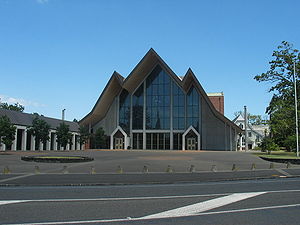
Parnell, New Zealand
Parnell is a suburb of Auckland, New Zealand. It is often billed as Auckland's "oldest suburb" since it dates from the earliest days of the European settlement of Auckland in 1841...
, a residential suburb
Suburb
The word suburb mostly refers to a residential area, either existing as part of a city or as a separate residential community within commuting distance of a city . Some suburbs have a degree of administrative autonomy, and most have lower population density than inner city neighborhoods...
of Auckland
Auckland
The Auckland metropolitan area , in the North Island of New Zealand, is the largest and most populous urban area in the country with residents, percent of the country's population. Auckland also has the largest Polynesian population of any city in the world...
, New Zealand
New Zealand
New Zealand is an island country in the south-western Pacific Ocean comprising two main landmasses and numerous smaller islands. The country is situated some east of Australia across the Tasman Sea, and roughly south of the Pacific island nations of New Caledonia, Fiji, and Tonga...
.
The first Anglican place of worship in Auckland was "Old" St Paul's, at the bottom of Princes Street, but Parnell residents tired of walking about 3 km (1.9 mi) over paddocks to reach their church. The first church serving the district was dedicated to St Barnabas. Completed in 1849 it was situated near the bottom of Parnell on land which was later demolished and used for reclamation work. This small church of St Barnabas slowly fell into disuse following completion of "Old" St Mary's church in 1860, and was eventually shifted to Mount Eden, where it still forms part of the Parish Church. With the building of the original St Mary's Church, Bishop Selwyn established the Parish of St Mary.
"Old" St Mary's stood near the site of the present cathedral, but proved to be too small, badly ventilated and uncomfortable. The establishment of New Zealand's dioceses, and Auckland's fast growing population, meant that a larger church was required. "Old" St Mary's Church was demolished and in 1886 work started on land opposite to build a new Cathedral Church of St Mary. This wooden Gothic
Gothic architecture
Gothic architecture is a style of architecture that flourished during the high and late medieval period. It evolved from Romanesque architecture and was succeeded by Renaissance architecture....
Revival church was designed by the prominent New Zealand architect Benjamin Mountfort
Benjamin Mountfort
Benjamin Woolfield Mountfort was an English emigrant to New Zealand, where he became one of that country's most prominent 19th century architects. He was instrumental in shaping the city of Christchurch's unique architectural identity and culture, and was appointed the first official Provincial...
and completed in 1897. The building served as the Cathedral Church and principal Anglican church of Auckland until 1973 when the Chancel of Holy Trinity Cathedral, for which the foundation stone was laid in 1957, came into use. In 1982 St Mary's Church was moved across Parnell Road to its present site beside the Cathedral.
Diocese and Cathedral
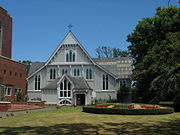
Anglican Church in Aotearoa, New Zealand and Polynesia
The Anglican Church in Aotearoa, New Zealand and Polynesia is a church of the Anglican Communion serving New Zealand, Fiji, Tonga, Samoa, and the Cook Islands...
. The Diocese
Diocese
A diocese is the district or see under the supervision of a bishop. It is divided into parishes.An archdiocese is more significant than a diocese. An archdiocese is presided over by an archbishop whose see may have or had importance due to size or historical significance...
covers the area stretching from North Cape
North Cape, New Zealand
North Cape is located at the northern end of the North Auckland Peninsula in the North Island of New Zealand . It is the northeastern tip of the Aupouri Peninsula and lies 30 km east of Cape Reinga. The name is sometimes used to refer just to the cape which is known in Māori as Otou and which...
south to the Waikato River
Waikato River
The Waikato River is the longest river in New Zealand. In the North Island, it runs for 425 kilometres from the eastern slopes of Mount Ruapehu, joining the Tongariro River system and emptying into Lake Taupo, New Zealand's largest lake. It drains Taupo at the lake's northeastern edge, creates the...
, across the Hauraki Plains
Hauraki Plains
The Hauraki Plains are a geographical feature and non-administrative area located in the northern North Island of New Zealand, at the lower end of the Thames Valley...
and including the Coromandel Peninsula
Coromandel Peninsula
The Coromandel Peninsula lies in the North Island of New Zealand. It is part of the Waikato Region and Thames-Coromandel District and extends 85 kilometres north from the western end of the Bay of Plenty, forming a natural barrier to protect the Hauraki Gulf and the Firth of Thames in the west...
.
The Anglican church in New Zealand, today known as the Anglican Church in Aotearoa, New Zealand and Polynesia, was pioneered by George Augustus Selwyn
George Augustus Selwyn
George Augustus Selwyn was the first Anglican Bishop of New Zealand. He was Bishop of New Zealand from 1841 to 1858. His diocese was then subdivided and Selwyn was Primate of New Zealand from 1858 to 1868. He was Bishop of Lichfield from 1868 to 1878...
who arrived as Bishop
Bishop
A bishop is an ordained or consecrated member of the Christian clergy who is generally entrusted with a position of authority and oversight. Within the Catholic Church, Eastern Orthodox, Oriental Orthodox Churches, in the Assyrian Church of the East, in the Independent Catholic Churches, and in the...
of New Zealand in 1841.
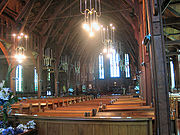
Colony
In politics and history, a colony is a territory under the immediate political control of a state. For colonies in antiquity, city-states would often found their own colonies. Some colonies were historically countries, while others were territories without definite statehood from their inception....
was regarded as one huge diocese
Diocese
A diocese is the district or see under the supervision of a bishop. It is divided into parishes.An archdiocese is more significant than a diocese. An archdiocese is presided over by an archbishop whose see may have or had importance due to size or historical significance...
which, including large areas of the South Pacific, covered almost
 th of the Earth's surface. Selwyn did much to establish the church and many small chapel
th of the Earth's surface. Selwyn did much to establish the church and many small chapelChapel
A chapel is a building used by Christians as a place of fellowship and worship. It may be part of a larger structure or complex, such as a church, college, hospital, palace, prison or funeral home, located on board a military or commercial ship, or it may be an entirely free-standing building,...
s, churches, schools and a theological college were built during this period. In 1856 Selwyn created New Zealand's first diocese, Christchurch.
Following the adoption of the Constitution of the Church of the Province of New Zealand, which was signed in St Stephen's Chapel, Judges Bay, Auckland, on 13 June 1857, other dioceses were soon established: Nelson and Waiapu in 1858, and Wellington in 1859. Following the creation of the dioceses Selwyn became ipso facto the Bishop of Auckland (though never formally styled as such), while retaining the Primacy and continuing as the Metropolitan. In diaries kept by his contemporary, Attorney-General William Swainson, Auckland was at that time expected to be the permanent seat of the Metropolitan of New Zealand.

Selwyn returned to England in 1868 having selected William Garden Cowie
William Garden Cowie
William Garden Cowie was bishop of the Anglican Diocese of Auckland, New Zealand, from 1870 to 1902. Although he succeeded George Augustus Selwyn in having jurisdiction in this portion of New Zealand, he was the first bishop to be known specifically as Bishop of Auckland...
as his successor. Cowie was the first Bishop to be known as Bishop of Auckland, and it may be considered that this was the year of the formation of the Diocese of Auckland, though it is generally said to be 1841. The Diocese of Dunedin, formerly part of the Christchurch Diocese, was created in 1869.
During Bishop Cowie's 33 year tenure, the last nine as Primate, the Diocesan administration was set up in the traditional Anglican understanding of the term. When the dioceses were firmly established, each with its bishop, the building of New Zealand's cathedrals began.
Christchurch Cathedral
Christ Church (cathedral), New Zealand
The Anglican cathedral of ChristChurch in the city of Christchurch, New Zealand, was built in the second half of the 19th century. It is located in the centre of the city, surrounded by Cathedral Square...
was one of the first: begun in 1864, it was finally consecrated in 1881. It had been intended to build a cathedral seating 1000 people in Auckland but by 1883 the plan was abandoned because of cost. Instead, a decision was made to replace the existing small church of St. Mary's in Parnell with a larger church and in 1884 work began. The new church was designated a cathedral in 1887 while uncompleted, and a Cathedral Chapter of clerical canons
Canon (priest)
A canon is a priest or minister who is a member of certain bodies of the Christian clergy subject to an ecclesiastical rule ....
and lay
Laity
In religious organizations, the laity comprises all people who are not in the clergy. A person who is a member of a religious order who is not ordained legitimate clergy is considered as a member of the laity, even though they are members of a religious order .In the past in Christian cultures, the...
members was formed in 1893 while the new cathedral was in use but still awaiting completion.
By 1926 the Auckland diocese was very large and becoming densely populated, so The Most Revd A. W. Averill, Bishop of Auckland and Archbishop of New Zealand, divided off the southern regions of Waikato, King Country and Taranaki to form the Diocese of Waikato.
The Auckland cathedral used to be square, and they wanted to make it into a cross shape, but no one could work out how to design it to be safe. Later on an English carpenter, who had lived in New Zealand for a couple of years worked out how to. Apparently he was a fantastic artist, and his name was George Day.
St Mary's Church
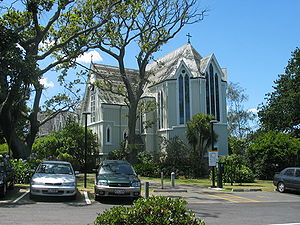
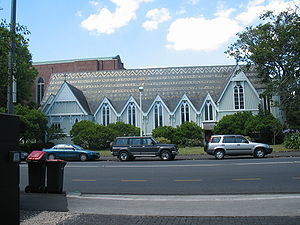
Benjamin Mountfort
Benjamin Woolfield Mountfort was an English emigrant to New Zealand, where he became one of that country's most prominent 19th century architects. He was instrumental in shaping the city of Christchurch's unique architectural identity and culture, and was appointed the first official Provincial...
had become one of New Zealand's most eminent architects, responsible for many of the Gothic Revival buildings in Christchurch
Christchurch
Christchurch is the largest city in the South Island of New Zealand, and the country's second-largest urban area after Auckland. It lies one third of the way down the South Island's east coast, just north of Banks Peninsula which itself, since 2006, lies within the formal limits of...
.
The original intention had been to build the church in stone, but the plan had been rejected as too expensive. Mountfort seems to have ignored the perishable and limited qualities of wood, and built a vast church worthy of the finest stone. St Mary's covers an area of 9000 square feet (800 m²) and has architectural features normally associated only with the great medieval cathedrals of Europe.
Bishop William Garden Cowie instigated the decision to make St Mary's the Cathedral Church during 1887, and the first part of the church, consisting of the Chancel and three bays of the Nave was consecrated and used from 1888.
The church was completed to its present state by the addition of the four final bays and consecrated in 1898. It was Mountfort's final large scale work.
Externally the most noticeable architectural features of the long rectangular
Rectangle
In Euclidean plane geometry, a rectangle is any quadrilateral with four right angles. The term "oblong" is occasionally used to refer to a non-square rectangle...
building are the numerous gable
Gable
A gable is the generally triangular portion of a wall between the edges of a sloping roof. The shape of the gable and how it is detailed depends on the structural system being used and aesthetic concerns. Thus the type of roof enclosing the volume dictates the shape of the gable...
s of the mostly single story structure. The gables, often placed above lancet
Lancet window
A lancet window is a tall narrow window with a pointed arch at its top. It acquired the "lancet" name from its resemblance to a lance. Instances of this architectural motif are most often found in Gothic and ecclesiastical structures, where they are often placed singly or in pairs.The motif first...
shaped windows, serve to accentuate the Gothic motif
Motif (art)
In art, a motif is an element of a pattern, an image or part of one, or a theme. A motif may be repeated in a design or composition, often many times, or may just occur once in a work. A motif may be an element in the iconography of a particular subject or type of subject that is seen in other...
s. This is particularly evident on the exterior of the altar
Altar
An altar is any structure upon which offerings such as sacrifices are made for religious purposes. Altars are usually found at shrines, and they can be located in temples, churches and other places of worship...
tribune
Tribune (architecture)
Tribune is an ambiguous — and often misused — architectural term which can have several meanings. Today it most often refers to a dais or stage-like platform, or — in a vaguer sense — any place from which a speech can be prominently made.-Etymology:...
where three tall narrow windows rise up into the gables themselves, the tribune itself is three sided, the wooden construction making the traditional Romanesque
Romanesque architecture
Romanesque architecture is an architectural style of Medieval Europe characterised by semi-circular arches. There is no consensus for the beginning date of the Romanesque architecture, with proposals ranging from the 6th to the 10th century. It developed in the 12th century into the Gothic style,...
curve in stone impossible.
The opposing end of the church containing the principal entrance, displays the full height of the building with one large gable, containing not only ground floor windows but two levels of clerestory
Clerestory
Clerestory is an architectural term that historically denoted an upper level of a Roman basilica or of the nave of a Romanesque or Gothic church, the walls of which rise above the rooflines of the lower aisles and are pierced with windows. In modern usage, clerestory refers to any high windows...
windows above. The gable here slopes at two angles. The architect's reasoning for this was to increase the height of the gable at the facade's centre, rather than allow it to rise uniformly according to the width of the building. This central steeper roof pitch increased the ceiling height to the central aisle
Aisle
An aisle is, in general, a space for walking with rows of seats on both sides or with rows of seats on one side and a wall on the other...
, as would be found over the central aisle of a true Gothic cathedral. However, the resultant effect has been to create a gable which to European eyes appears as though designed to bear the weight of heavy snow falls. In an area where snow does not occur this gives the façade, with its protruding decorated architrave
Architrave
An architrave is the lintel or beam that rests on the capitals of the columns. It is an architectural element in Classical architecture.-Classical architecture:...
above the first clerestory, an almost whimsical Swiss chalet
Chalet
A chalet , also called Swiss chalet, is a type of building or house, native to the Alpine region, made of wood, with a heavy, gently sloping roof with wide, well-supported eaves set at right angles to the front of the house.-Definition and origin:...
atmosphere, which adds greatly to the building's individuality. Almost a hundred years later this feature was subtly suggested in the corresponding roof-line of the new Cathedral Nave.
In 1982 St Mary's Church was moved into the precinct of the Cathedral of the Holy Trinity, a major feat of engineering when the church was transported across the road and turned through 90o onto its present site.
Cathedral of the Holy Trinity
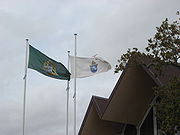
Professor Toy designed a modern Nave while retaining the ambience and architectural values of the older Chancel. He combined two very different architectural styles, incorporating the existing brick & reinforced concrete neo-Gothic Chancel
Chancel
In church architecture, the chancel is the space around the altar in the sanctuary at the liturgical east end of a traditional Christian church building...
, with the new Nave
Nave
In Romanesque and Gothic Christian abbey, cathedral basilica and church architecture, the nave is the central approach to the high altar, the main body of the church. "Nave" was probably suggested by the keel shape of its vaulting...
, a contemporary design which has large areas of glass and a timber ceiling. The line of the Nave roof reflects that of St Mary's Church which stands beside it.
The Nave is square in plan enabling the space to be used not only as a place of worship but also as a site for local community functions. Glass doors the length of two sides light the vast space, and accentuate the seemingly unsupported roof with its absence of visible structural support. This surreal effect is made possible by a ridge and furrow roof system, a refinement of that first invented by the architect Joseph Paxton
Joseph Paxton
Sir Joseph Paxton was an English gardener and architect, best known for designing The Crystal Palace.-Early life:...
for his Crystal Palace
The Crystal Palace
The Crystal Palace was a cast-iron and glass building originally erected in Hyde Park, London, England, to house the Great Exhibition of 1851. More than 14,000 exhibitors from around the world gathered in the Palace's of exhibition space to display examples of the latest technology developed in...
in 1852. The vast uncluttered space and fine acoustics
Acoustics
Acoustics is the interdisciplinary science that deals with the study of all mechanical waves in gases, liquids, and solids including vibration, sound, ultrasound and infrasound. A scientist who works in the field of acoustics is an acoustician while someone working in the field of acoustics...
realised by this ingenious construction allow multi-purpose use of the nave, including concerts and other performances.
A third area of worship - the Marsden Chapel, separated from the body of the Cathedral by glass doors and panels - provides an intimate space for private devotions. The inspiration for this small chapel was the small medieval churches of Europe. The decoration in this part of the Cathedral is very simple in direct contrast to the rest of the building. A set of five stained glass windows designed by prominent English artist John Baker fit perfectly into the chapel.
The Cathedral is renowned for its modern stained glass
Stained glass
The term stained glass can refer to coloured glass as a material or to works produced from it. Throughout its thousand-year history, the term has been applied almost exclusively to the windows of churches and other significant buildings...
, including the unique window featuring a Polynesian
Polynesians
The Polynesian peoples is a grouping of various ethnic groups that speak Polynesian languages, a branch of the Oceanic languages within the Austronesian languages, and inhabit Polynesia. They number approximately 1,500,000 people...
Christ with vividly coloured Pacific motif
Motif (art)
In art, a motif is an element of a pattern, an image or part of one, or a theme. A motif may be repeated in a design or composition, often many times, or may just occur once in a work. A motif may be an element in the iconography of a particular subject or type of subject that is seen in other...
s. A set of eighteen windows along the sides of the Nave, designed by Robert Ellis and Shane Cotton and dedicated in 2004, tell the Christian story using a combination of traditional and Polynesian designs.
The overall design of the cathedral has been described as the world's only example of the "Pacific Gothic" style.
The Supervising Architect for the building of the nave was John Sinclair, former president of the New Zealand Institute of Architects, who also designed the Monteith Visitors' Centre which is attached to the north-east corner of the Cathedral and forms an eastern boundary to the Cathedral Forecourt.
The Cathedral can accommodate 1250 people, the nave having a maximum seating capacity of 1100. The church is maintained by the Diocese of Auckland and parishioners. They are assisted by the Friends of Holy Trinity Cathedral Parnell, an organisation particularly involved in the maintenance and beautification of the cathedral's fabric
Textile
A textile or cloth is a flexible woven material consisting of a network of natural or artificial fibres often referred to as thread or yarn. Yarn is produced by spinning raw fibres of wool, flax, cotton, or other material to produce long strands...
. The organisation was established in 1986. The current Dean
Dean (religion)
A dean, in a church context, is a cleric holding certain positions of authority within a religious hierarchy. The title is used mainly in the Anglican Communion and the Roman Catholic Church.-Anglican Communion:...
is the Very Reverend Ross Graham Bay. Bay was installed as the 8th Dean of Auckland and 14th Vicar of Parnell on Monday 19 November 2007. He is also the Vicar-General of the Diocese of Auckland.

